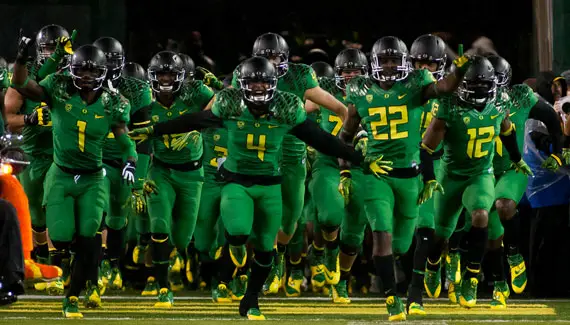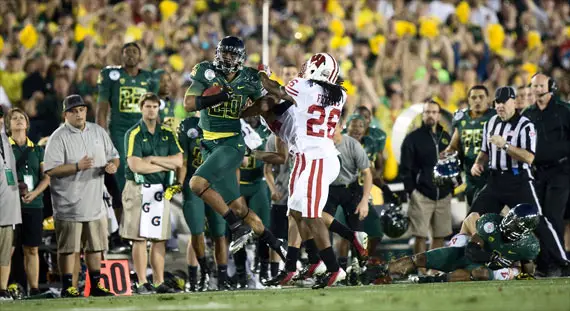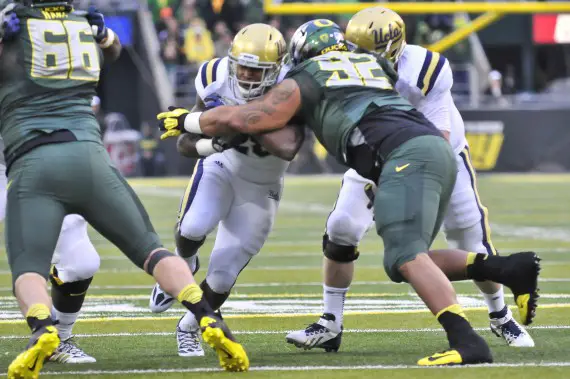Two of the signature days on the football calendar brought the season to a close last week. The first was last Sunday in the form of the Super Bowl, sport’s biggest spectacle, but also one of the truest meritocracies; the team that executes better on the field wins, and does so by presumably having the best combination of player talent and production possible from them.
The second overlapped the spoils of the first: On the same day the Seattle Seahawks held a parade celebrating their accomplishment on pro football’s biggest day, college football held its signature event: National Letter of Intent Signing Day.
It makes sense that the Super Bowl and Signing Day are the most noteworthy days on the calendar for their respective levels of the sport, because those are the days that are the most symbolic of how success is measured in each. Success in pro football is determined entirely on the field with all participants having an equal opportunity to win, while college football is still largely determined by a series of academic arguments, where reputation and speculation matter as much as production. It is only fitting that the most celebrated day in college football would be the one celebrating the most speculative portion of the sport: recruiting.
On that same day, perhaps mindful of the day’s significance in talent-evaluation circles and how he and many of his teammates had been “perceived” during their signing days, Seahawks quarterback Russell Wilson posted this on his Twitter:
The 2012 @seahawks draft class. They graded us as an F. Now we are World Champs! #GodisGood #GoHawks pic.twitter.com/HuOjkuOYVa
— Russell Wilson (@DangeRussWilson) February 5, 2014
The “F” grade Wilson is referring to came from this article , a hilarious re-read that includes pointed criticisms of the selections of Ryan Tannehill and Alshon Jeffery. When you examine the players in Wilson’s picture, it’s no surprise why their class wasn’t more highly regarded in NFL circles on draft day.
Of all the players featured in that picture, none were ranked higher than three stars coming out of high school, which may explain why only five of them (Wilson, Bruce Irvin, Derrick Coleman, Jermaine Kearse, and J.R. Sweezy) even played for schools in BCS AQ conferences. They were all players who got used to being overlooked, yet all of them became NFL players who contributed to a Super Bowl-winning team.
Not seen in the picture but a player who began his career with that Seahawks’ 2012 class is former Oregon receiver Lavasier Tuinei. Tuinei fits the mold of other players from that draft class, a two-star wide receiver who started at a junior college before finishing his career at Oregon. He is fondly remembered by Oregon fans as the team’s leading receiver in 2011, punctuating his career by winning Rose Bowl Offensive Player of the Game with an eight-catch, 155-yard performance that helped the Ducks win their first Rose Bowl in 95 years.
I mention Tuinei and the Seahawks because the majority of the discussion surrounding Oregon’s recruiting class last week focused on the players the other teams didn’t get, rather than focusing on who they did.
Maybe it was the early commitment of its most highly-regarded recruits in this class, or the lack of a marquee name changing their commitment to Oregon on Signing Day like the de-commitment of players such as Budda Baker, or how players such as Juju Smith or Trey Lealaimatafao chose to sign elsewhere, rather than focusing on the gains of the players who have committed; playing the what-if game before we even know what the productivity of those players, who will play elsewhere, will be.
If you want an example of why it is premature to evaluate recruiting classes based on high school rankings, look no further than a class like the one Texas had in 2009. Coming off a 12-1 season where they won the Fiesta Bowl, and because they are Texas, the Longhorns were able to bring a class that featured three five-stars (including one at quarterback) and eleven four-stars, with not a single player lower than a three star.
That class was a “disaster” (their words) that set the program back several years and potentially cost Mack Brown his job, yet at the time was regarded as a top-five class in the country.
I understand the fascination with Signing Day because it gives fans hope. There is the belief that landing a huge talent will be a game-changer for a program. However, that hope shouldn’t turn to despair just because players don’t sign with Oregon. Fans want to treat players as interchangeable commodities, that any of these players could (or should) play for the Ducks.
Yet any entry-level staffing manager could tell you that the greatest key to success isn’t if he has talent, it’s if he can fit. If a player doesn’t feel he belongs at a certain school, there’s no reason to have them go there. Concentrating energy on players who want to be in Eugene rather than leveraging those who are unsure about going there will have a far greater long-term payoff. This is where Oregon’s coaches have done a tremendous job in recent seasons, finding guys who fit their program rather than chasing star rankings.
Bill Parcells once said, in reference to his desire to be involved in personnel decisions, “If they want you to cook the dinner; at least they ought to let you shop for some of the groceries.” Evaluating a recruiting class on Signing Day is a lot like evaluating a meal by looking at the ingredients. Sure, we can all see what quality cuts of meat and fresh produce look like, but if it’s not prepared in a competent way, it doesn’t matter what ingredients you start with.
This is why Oregon’s recruiting classes need to be evaluated strictly on wins and losses, the finished product of recruiting. If the results don’t measure up, and evidence of such failings can be traced back to recruiting, by all means take up the necessary pitchforks and torches and storm the complex. But evaluating recruiting classes now is nothing more than determining who did the best job of shopping for the groceries. There’s still a meal to be made, and the quality of that meal is the criteria by which fans should use to judge programs.
Top photo courtesy of Craig Strobeck
Related Articles:
Chip Kelly Update: Everything's Good Again ...
Chip Kelly Update: Wailing and Gnashing of Teeth
Shock and Awe -- The Oregon Ducks' Football Hangover Effect
Despite Lopsided Score, Georgia State "Never Stopped Believing"
Hope Springs Eternal for Ducks
Incompetent Pac-12 Officials: How Do You Miss ALL of THIS?
Nathan Roholt is a senior writer and managing editor emeritus for FishDuck. Follow him on Twitter @nathanroholt. Send questions/feedback/hatemail to nroholtfd@gmail.com.



